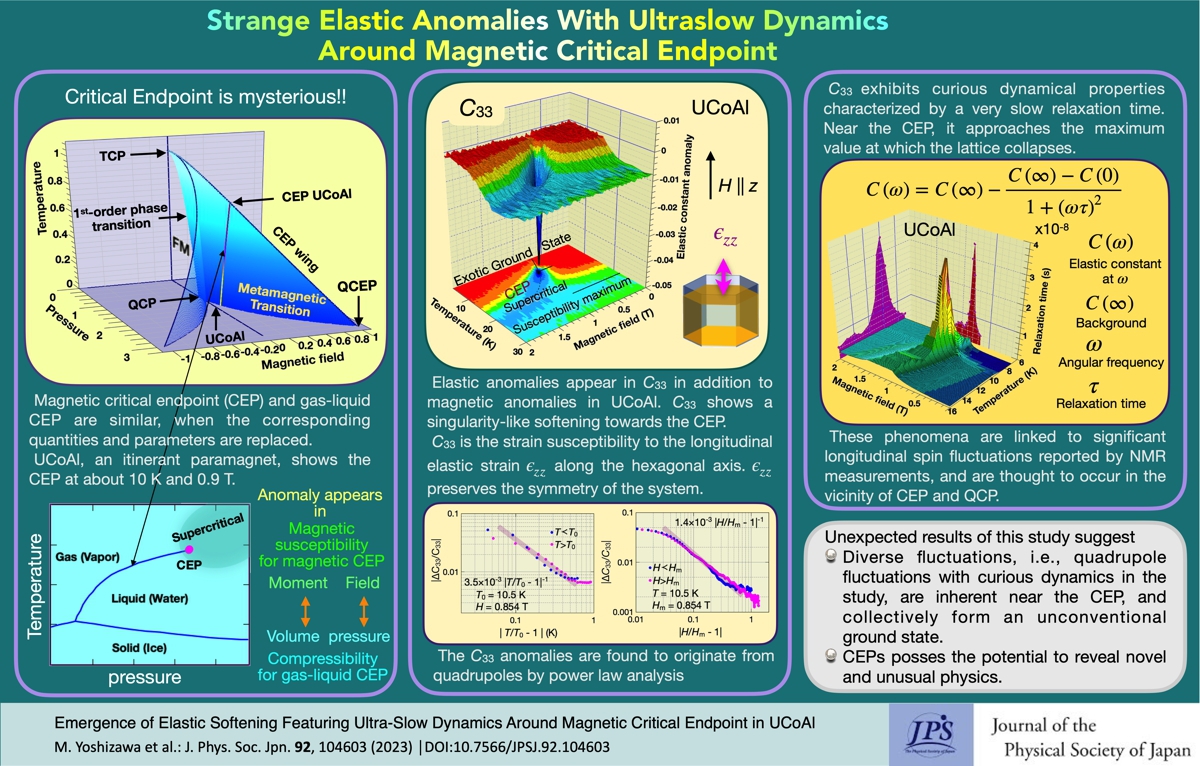Strange Elastic Anomalies with Ultraslow Dynamics around Magnetic Critical Endpoint
© The Physical Society of Japan
This article is on
J. Phys. Soc. Jpn.
92,
104603
(2023)
.
Near the magnetic critical endpoint of UCoAl, peculiar elastic anomalies exhibiting exotic ultraslow dynamics arising from electric quadrupoles are indicated. Combining this with diverse fluctuations, intriguing phenomena and exotic ground states are expected.

Since the mathematical description of boundary-separating gas and liquid states by van der Waals, the critical endpoint (CEP) has garnered the attention of many researchers because of its intriguing nature. At high temperatures and pressures, water achieves a CEP, in which the gas and liquid phases coexist harmoniously. An anomaly in the compressibility emerges in the water CEP. In magnetic materials, CEP appears as a function of temperature and the magnetic field. The magnetic susceptibility shows an anomaly in the magnetic CEP. Gas-liquid and magnetic CEPs are assumed to be similar. Nevertheless, the presence of non-magnetic fluctuations is unanticipated in magnetic CEPs.
UCoAl, which is an itinerant paramagnet, is located near both the tri-critical point and the quantum critical point (QCP). At ambient pressure, a CEP was observed at approximately 10 K and 0.9 T. In this study, ultrasonic sound velocities ranging from 12 to 106 MHz were measured, and the elastic constant C33, which represents the strain susceptibility for elastic strain (displacement along the hexagonal axis), was obtained. We observed a singularity-like elastic softening toward the CEP and discovered that this anomaly cannot be attributed to magnetostrictive coupling. Power law analyses indicate that it originates from electric quadrupoles.
Furthermore, C33exhibited a fascinating ultrasonic dispersion effect, in which the elastic anomaly diminished as the frequency increased. The recorded relaxation time of 3.5 × 10-8 s at the CEP is the lowest value reported thus far for solids. This value approached the maximum value, at which the crystal collapsed, thus indicating significant structural fluctuations.
Based on NMR studies, UCoAl exhibits pronounced longitudinal spin fluctuations related to the C33 anomaly. The crystal symmetry of UCoAl remains unchanged at CEPs, and maintains the symmetry of the crystal. Fluctuations in the magnetic and structural properties that retain symmetry coevolve toward the CEP. The unconventional slow dynamics indicate the existence of an exotic ground state in this system, which is believed to emerge near the CEP in distinct and extreme environments.
Recently, peculiar superconducting and quadrupolar states were observed in URhGe, UTe2, and URhSn. The distinct features of UCoAl near the CEP are speculated to be associated with the enigmatic properties of these compounds.
CEPs contribute to various fields ranging from industrial processes to particle physics. Despite extensive research, the nature of CEPs remains unclear. CEPs can potentially reveal novel and unusual physics, thus presenting an interesting avenue for investigating undisclosed facets of matter.
Written by M. Yoshizawa on behalf of all the authors.
J. Phys. Soc. Jpn.
92,
104603
(2023)
.
Share this topic
Fields
Related Articles
-
Qualitative Changes in Kinetic Pathways Driven by Hydrodynamic Interactions in Dense Colloidal Suspensions
Cross-disciplinary physics and related areas of science and technology
Statistical physics and thermodynamics
Structure and mechanical and thermal properties in condensed matter
2025-4-18
Even in dense colloidal suspensions, where long-range hydrodynamic interactions are screened, near-field hydrodynamic interactions qualitatively influence the selection of kinetic pathways.
-
Higher-Order Topological Phases in Magnetic Materials with Breathing Pyrochlore Structures
Electronic structure and electrical properties of surfaces and nanostructures
Magnetic properties in condensed matter
Mathematical methods, classical and quantum physics, relativity, gravitation, numerical simulation, computational modeling
2025-4-7
A simple example of a higher-order topological phase, in which the symmetry decreases step-by-step from the bulk to the corner, is realized in a magnetic system with a pyrochlore structure and is characterized by a series of quantized Berry phases defined for the bulk, surface, and edge.
-
Existence of Chiral Soliton Lattices (CSLs) in Chiral Helimagnet Yb(Ni1-xCux)3Al9
Magnetic properties in condensed matter
2025-4-1
Our study examines the magnetic structure of the monoaxial chiral helimagnet Yb(Ni1-xCux)3Al9, providing first direct evidence of the formation of chiral soliton lattice state.
-
Understanding Pressure-Induced Superconductivity in CrAs and MnP
Magnetic properties in condensed matter
2025-3-10
This study reviews existing research on the pressure-induced variation of magnetic properties of transition metal mono-pnictides like CrAS, MnP, and others, aiming to understand the unconventional superconductivity observed in CrAs and MnP.
-
Symmetry and AI: Building the Future of Physics Simulations
Magnetic properties in condensed matter
Measurement, instrumentation, and techniques
2025-2-18
Generative artificial intelligence (AI) has gained considerable attention in scientific fields. By embedding physical symmetry into AI before training, we created a faster and lighter model. Scaling improves the accuracy and unlocks the potential of physics research and applications.




